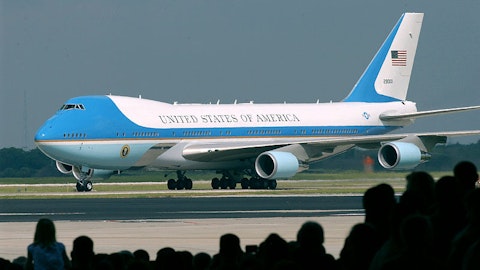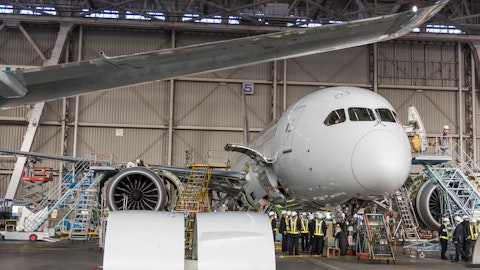Myles Walton: Thanks. Good morning. Just wanted to clarify a couple of things. One, Brian, I think you mentioned $600 million higher abnormal cost on the 787. Is that cash? Is that absorbed now in the ’23 unchanged free cash flow guidance? And then also for defense, if you can just touch on your margin profitability expectation and rough magnitude for 2023? Thanks.
Brian West: Sure. So in terms of the first question, we — the 787 abnormal, there is no cash impact. Part of that is just because part of that is just fixed cost absorption, but there’s no change in the cash outlook. It’s not significant in that regard. So we’re holding. On the defense margins. So in the quarter, as I mentioned, we had some bump around from the supply chain constraints and some of the labor, not just in the fourth quarter, as well as some of the timing of accruals that I mentioned. As we move our way into 2023, we clearly expect those margins to get better. It’s not going to be all the way back to what normal might look like, but it’s going to be improved sequentially. And we feel pretty good about the lineup in terms of the product portfolio.
And as we remind you is that the products are performing incredibly well with the customers. So we feel good about the underlying base is the BDS margins will get better, and we’re positioned for that as we head into the year.
Myles Walton: Alright. Thank you.
Operator: Next, we’ll go to Kristine Liwag with Morgan Stanley. Please go ahead.
Kristine Liwag: Good morning, everyone. Dave, you mentioned the milestone order from United despite the macroeconomic uncertainty in the near and medium term. So when you look at COVID-19 now approaching the rearview mirror, China reopening, I mean the demand for air travel has been pretty strong. Can you talk about what your customers are saying about potential new aircraft orders? Should we anticipate more airlines making landmark orders like United? And could we see BCA at a positive book-to-bill for the year?
Dave Calhoun: Yes. I — again, I always hesitate to forecast specific orders. I will say that we’re involved in more big orders now than we’ve been in a long time. I think last year was a big indicator for folks that big orders are out there. I think the United One is, in fact, indicative. But Delta earlier, there’s just — there are some big interest in aviation, I’d say, the majority now outside the U.S. as opposed to inside the U.S. And we’re considering some big — some really big things. And we’re in the midst of all of those. So yes, I have a — I’m pretty optimistic. I’m not going to forecast numbers because that’s never healthy. But I do think over the next couple of quarters, you’ll see some big decisions made to both manufacturers, and you’ll see some new entrants into the aviation world that aim to make a real difference, and again, largely in the global markets.
Kristine Liwag: Thanks, Dave. If I could do a follow-up, with that environment that you described, it sounds pretty robust. Can you describe the pricing environment for these orders and how they compared to pre-COVID levels?
Dave Calhoun: Yes. Well, when you’re in the midst of any one deal, it feels ruthless. But if you really do balance it out, and I guess I credit both manufacturers, it’s been pretty disciplined through this whole COVID moment. And so you see very few reaches and sort of crazy things that are out of the norm. And now we’re in sort of that supply chain constrained world where people simply want to get positions so that they know they have airplanes when the time comes. Recessions don’t seem to get in the way because remember, we’re competing for deliveries out four and five years from now. So they’re not really computing recession into that. So anyway, again, I feel good, and I also — I’m going to guess that — because it’s always a guess that pricing will stay disciplined.
Kristine Liwag: Thank you.
Operator: And next, we’ll go to Seth Seifman with JPMorgan. Please go ahead.
Seth Seifman: Thanks very much. Good morning. And really, I guess, just a little bit of a quick clarification this morning rather than a question. Just making sure to understand the difference between production and deliveries this year on 737. When you say the high end of the guidance is assuming low 30s and moving to high 40s you’re talking deliveries there. And then with regard to production, when you say that you are kind of hoping to get to a place where you see some stability this year, that’s with regard to production in the factory. And so that would make it very — make it seem unlikely that the production rate is going higher than 31% this year. Is that a fair way to think about things regardless of where that delivery shake out?
Brian West: You’re right on characterizing the delivery framework. And I would say that as we move through the course of the year and we’ll have fewer inventoried airplanes, that will put a little bit more opportunity on units come out of the factory. So production rate at the right moment could get higher. We’ll wait and see. We’re just going to stick to the range for now.
Dave Calhoun: And as a reminder that we’re not shooting for the low end of the range.




